Socialist Realism was an artistic trend that emerged and imposed itself in theUSSR (Union of Soviet Socialist Republics) from the mid-1920s, following the 1917 revolution, Lenin’s death and Stalin’s subsequent 1924 rise to power. Socialist Realism generally refers to the formally realistic but thematically artificial style of painting dictated by state power, which established a form of figurative representation in the service of political ideology. It developed in opposition to the aesthetics of the early 20th century Russian avant-garde, against the geometric abstraction and functionality of artworks introduced by Suprematism and Constructivism, in favor of a return to genre painting. However, the term Socialist Realism also encompasses much of the visual art produced in other communist nations from that period onward, as well as associated expressions in sculpture and architecture, literature, theater, and music.
Russia had an important history associated with realist painting, which in the nineteenth century had taken the direction of social criticism, denunciation of the conditions and issues of the peasant and working class, but as socialist rule began to take hold in the USSR artists were increasingly forced, on pain of otherwise exile, imprisonment or death, to present positive and propagandistic images of state choices in the new Soviet republics.
Repressing the free subjectivity of the avant-garde artists, who had revolutionized the canonical composition of the painting and used geometric shapes and basic colors and included to painting building materials to express the new values of industrialized society, the Soviet painters of the 1930s returned to realistic and descriptive visions of everyday life, in mostly static compositions with precisely delineated, positive and integrated subjects in the life of the state. In the 1930s and 1940s, Socialist Realism had extinguished critical expression and artistic experimentation, but channeled into its ranks the activities of technically gifted artists, writers, and composers. Painters, sculptors, and even photographers and filmmakers offered idealized images of political and cultural leaders, and of the new Russia’s way of life and work, in the most conventionally “realistic” manner possible.
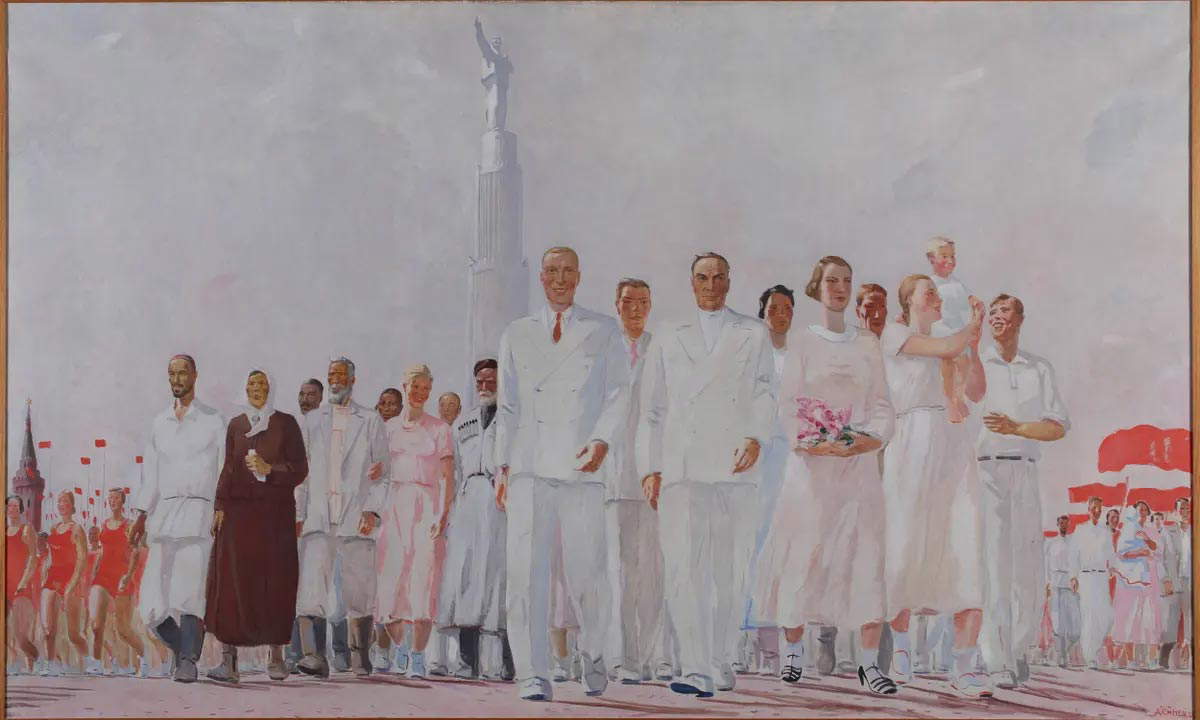

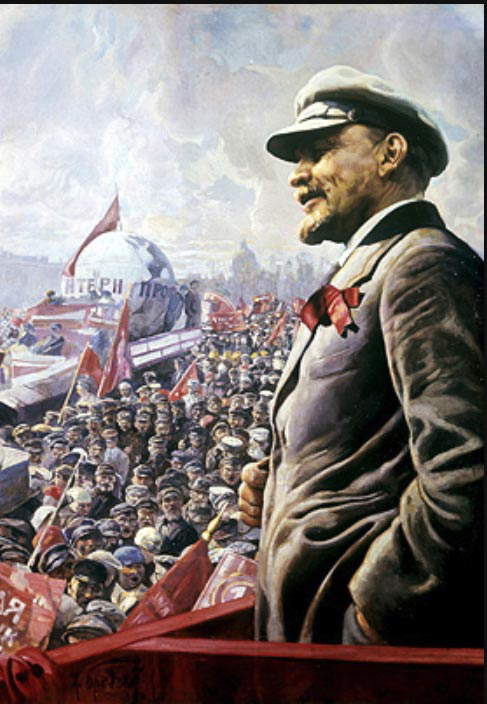
Socialist Realism constituted, until the collapse of communism, the official art of the Soviet Union and the socialist countries of Eastern Europe, based on principles officially theorized by politician Andrei Aleksandrovi? danov in 1934, the year of the creation of theSoviet Academy of Architecture and the First Congress of Soviet Writers. Socialist Realism, as a proletarian art form characterized by purely figurative research aimed at “the education of workers in the spirit of socialism,” took hold a decade earlier, however, proposing to surpass the Russian subversive avant-gardes of the 1920s, which, although in a declared attempt to give the arts a new social function, did not meet the real needs of the new USSR.
For a time, the experiments of Russian Cubo-Futurism, Suprematism and Constructivism were tolerated and even encouraged by the new Communist government: the Constructivist artist Naum Gabo, who emigrated to Germany in 1922, recalled that “at first we all worked for the government.” To a certain extent, this freedom showed that the Central Committee, the new governing body of the USSR, was paying not too much attention to cultural issues while grappling with the Russian Civil War of 1917-22. But precisely in 1922, the year the war ended and Stalin began to consolidate his control, the state was already beginning to condition freedom of creative expression; when Stalin came to power upon Lenin’s death in 1924, a more drastic change in culture followed. Unlike most movements in art history, Socialist Realism was imposed from above through informal pressure from the mid-1920s onward. Stalin had specific and prescriptive ideas about how art should serve the new state: it had to offer unequivocally positive images of life in communist Russia, in a realistic visual style that could be easily appreciated by the masses, “national in form, socialist in content,” thus used as propaganda. It was felt in that early period that the avant-garde had inaccessible languages, and many of the leading exponents fled to Europe to avoid isolation, prison or death, as would later happen in Nazi Germany.
One of the independent organs of Socialist Realism was theAssociation of Artists of Revolutionary Russia (AKhRR), founded in 1922, with offices in Moscow and Leningrad (now St. Petersburg). The AKhRR artists devoted themselves to producing paintings depicting the daily life of workers in post-revolutionary Russia, following the schools of Naturalism and Realism that in Europe and Russia had devoted their efforts to painting genre scenes featuring poor workers from the mid-19th century onward. The AKhRR group found inspiration in the work of the Red Army, urban workers as well as rural peasants, revolutionary activists, and Stakhanovist heroes: models of the Soviet role imposed on citizens, works the people could relate to. However, the group that saw among its ranks one of the greatest representatives of Soviet Realism Isaak Israilevi? Brodsky (Sofiivka, 1883 - Leningrad,1939), had a short existence, and in 1932 it was abolished, like all groups of artists not recognized by the state. They were followed by the painters including Aleksander Deyneka (Kursk, 1899 - Moscow, 1969) and Yuri Pimenov (Moscow, 1903 - 1977) of the Society of Easel Painters (OST) formed in Moscow in 1925, who proclaimed a return to the easel, precisely, opposing the revolutionary thesis of Constructivism of union between the arts in relation to engineering. The OST thus reaffirmed a more traditional and reactionary view of the role of the painter. Like the AKhRR, it was an independent group that split in two in 1928, when a number of painters more interested in formal abstraction broke away from Deyneka and Pimenov, until 1932, when it was disbanded.
The artworks from that time had to speak to the workers and reflect them, be nationalist in spirit, to represent the everyday life of the Russian people, and in support of the aims of the state and the Communist Party. The Central Committee announced that all existing literary and artistic groups would be disbanded, to be replaced by authorized state unions. This led to the founding of theUnion of Artists of the USSR, effectively ending the era of independent modern art in Russia, which had been vitally active since the 1860s. The era of State Socialist Realism actually began at this point, in ’32, although it was explicitly endorsed as a Stalinist policy only two years later, as mentioned, at the 1934 Congress of Soviet Writers and actively applied in all the arts. In the years following World War II, Socialist Realism was exported to the Eastern Bloc satellite states.
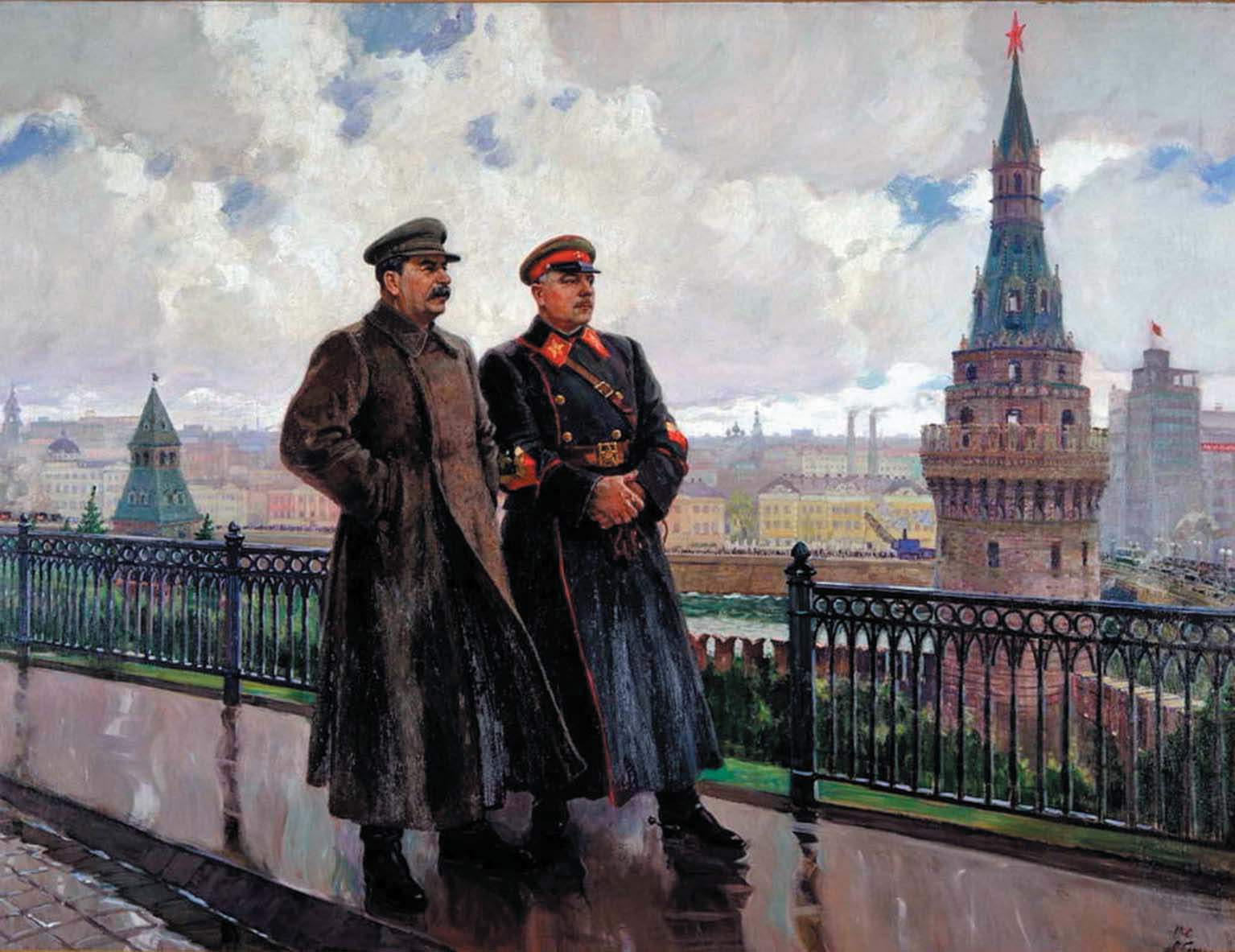
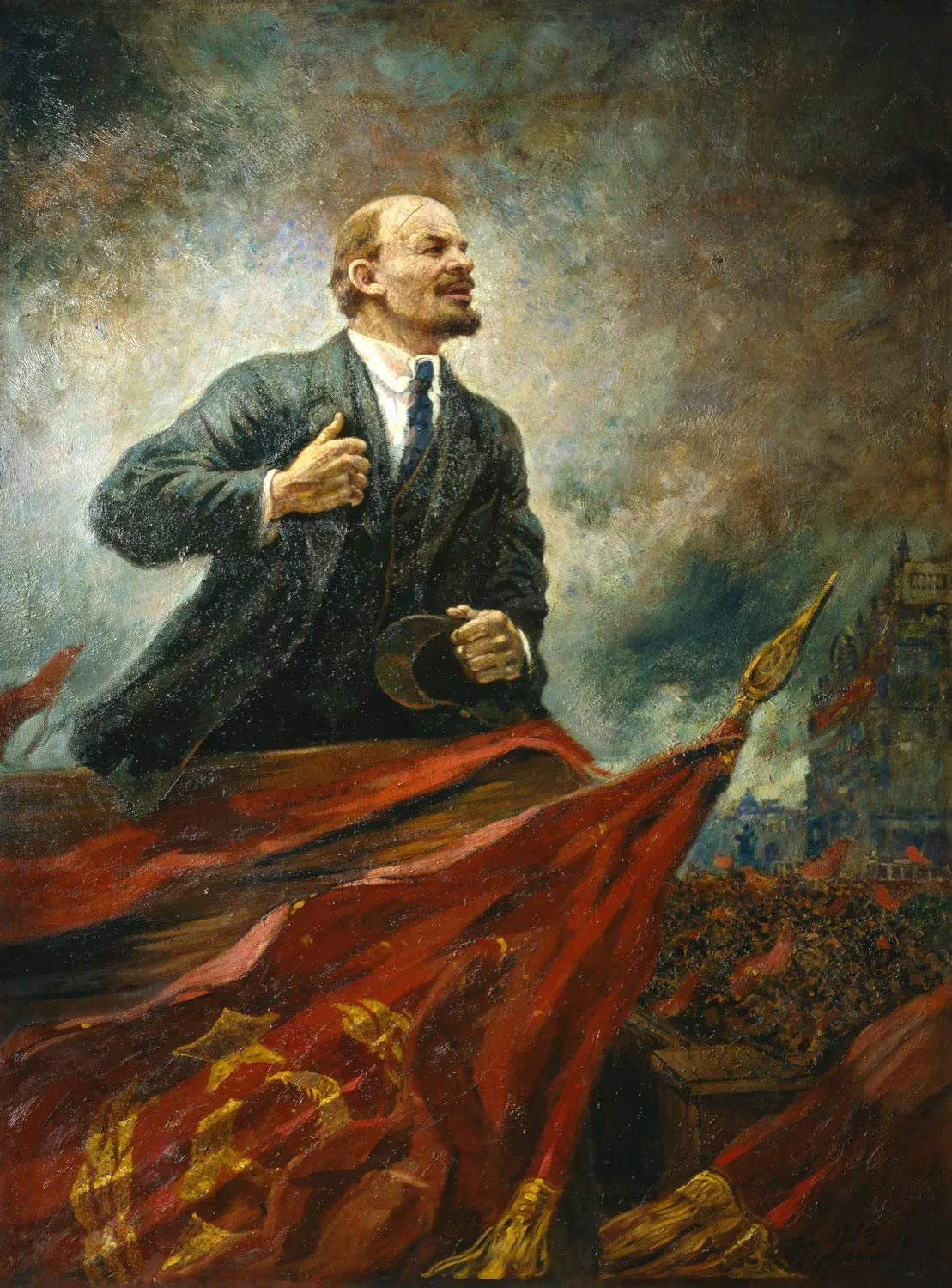
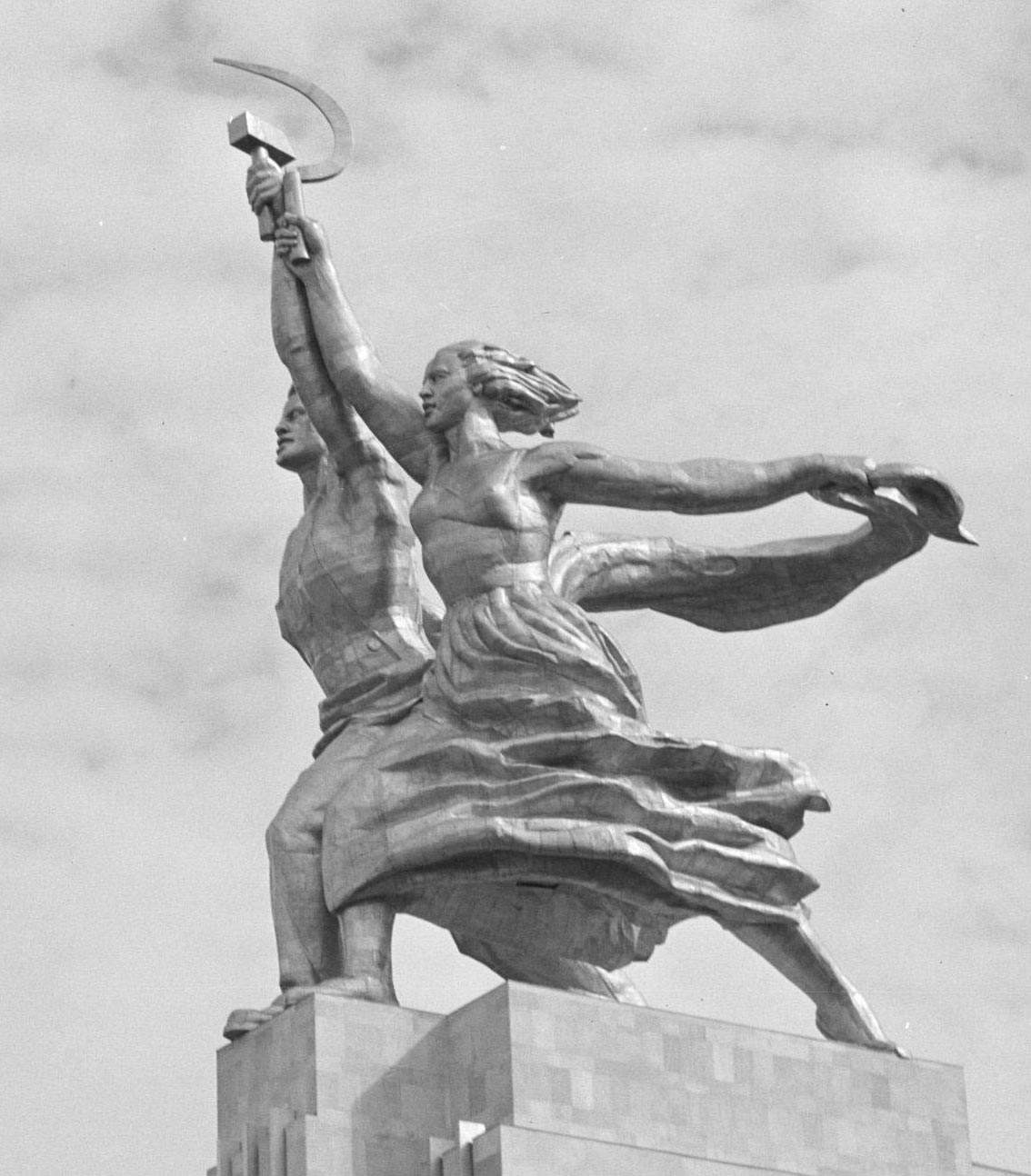
The style of Socialist Realism saw a return to drawing and painting from life in a very linear and precise manner. Some paintings were so realistic that they looked similar to color photography. But as much as these works retained the stylistic rendering of nineteenth-century Realism, they did not look to reality as a subject for interpretation. The artistic model was intransigent and delineated by the state, and was meant to be optimistic in spirit, realistic in style, and centered on the proletariat or individual heroes of the new republic, state figures or, as was more often the case, members of the working classes elevated to the level of celebrity, such as Alexey Stakhanov.
Stakhanov was known for setting astonishing records as a coal miner in 1935, working tirelessly to collect hundreds of tons of coal in a short time; he became a leading figure in a cult of productivity, which then became widely established with Stakhanovism after 1935, whose name alone stands for zealous efficiency at work.Deyneka’s Stakhanovisti of 1936, is a good example of the social function required of painting, depicting in fact the ideal community of Russian citizens in reference to a tireless worker for the Soviet cause. A procession of tall, happy, healthy, white-clad workers appears in front of the Soviet Palace, a building whose construction had not begun when the painting was composed, and which began the following year only to never be completed. In sum, creativity in Socialist Realism lay in the “staging of the image.”
Proletarian heroes like Stakhanov are the subjects of this period, from workers and scientists to civil engineers and peasants, all embodying the same spirit of individual will directed toward collectivist ideals. This, of course, was another driving force behind Socialist Realism: it was believed that the establishment of a collectivist society required an almost religious veneration of the individual. Starting with the leaders of the new state. In a pattern repeated across totalitarian cultures throughout the 20th century, these figures effectively took the place of religious icons in the public imagination, appearing in portraits and monumental posters. Much of this work was produced by talented painters such as Brodsky, who in the late 1920s and 1930s composed several paintings of Lenin during key stages of the Russian Revolution. As in Vladimir Lenin May 1, 1920 (1927), they celebrated the cult of personality that had grown up around Lenin and Stalin and the sense of optimism that artists were expected to convey. A leading figure in this sphere was Aleksandr Gerasimov (Kozlov, 1881 - Moscow, 1963), who specialized in adulatory portraits of the leadership(Stalin and Voroshilov in the Kremlin, 1938) and became head of the USSR Union of Artists and the Soviet Academy of Arts.
At the same time, the style gained a foothold in the public sphere through graphic art and photography, precisely through posters, even by unknown artists, mostly depicting workers of the proletariat engaged in industry, posted in the squares. Photography, called Socialist Realism, was a tool for public propaganda campaigns to capture the beaming faces of workers, framed from below or in close-up, again emphasizing the individual effort that propelled the Soviet Union forward.
Socialist Realism also expressed itself in sculpture, and despite the limitations imposed on the formal and thematic scope of the works, it engaged many talented artists, just as it did in painting. Among these sculptors was Vera Mukhina (Riga, 1889 - Moscow, 1953), who created one of the exemplary statues of the period, The Worker and the Kolkhozian in 1937. Standing 24.5 meters tall in stainless steel, it presents an optimistic image of the “Kolchoz” collective farming system implemented during Stalin’s first five-year plan (1928-32), despite the fact that “collective agricultural ownership” had in fact led to a decline in productivity. But Socialist Realist artists were required to extol the successful implementation of collectivization in spite of everything: the worker holds aloft a hammer and the Kolchozian, or Kolchoz peasant woman, a sickle, triumphantly recreating the symbol of the political movement with the hammer and sickle.
The propaganda of Socialist Realism thus acted, in a subtle way, conducted also, in addition to genre paintings, through depictions such as still life, which depicted abundance within the communist state. As much as compared to portraiture, these scenes had no explicit connection to political themes, they sent out winning messages of realistically less lush situations; hence the difference with what had been the Social Realism of the previous century, the new Russia in which these artists operated was very different from the one they were forced to depict.
Even in the field ofarchitecture, in which Russian Constructivism had acted in the immediately preceding years by eliminating the decorative superfluous (of 1929 is the first official rejection of Constructivist formalism declared by the group Proletarian Architects or VOPRA), it was gradually replaced by a monumental style considered more “readable” by the working classes. Characterized by the use of classical forms of academic tradition and overabundant decoration, it fully represented the thrust of the Soviet Union.
 |
| Socialist realism. Origins, development and main exponents |
Warning: the translation into English of the original Italian article was created using automatic tools. We undertake to review all articles, but we do not guarantee the total absence of inaccuracies in the translation due to the program. You can find the original by clicking on the ITA button. If you find any mistake,please contact us.